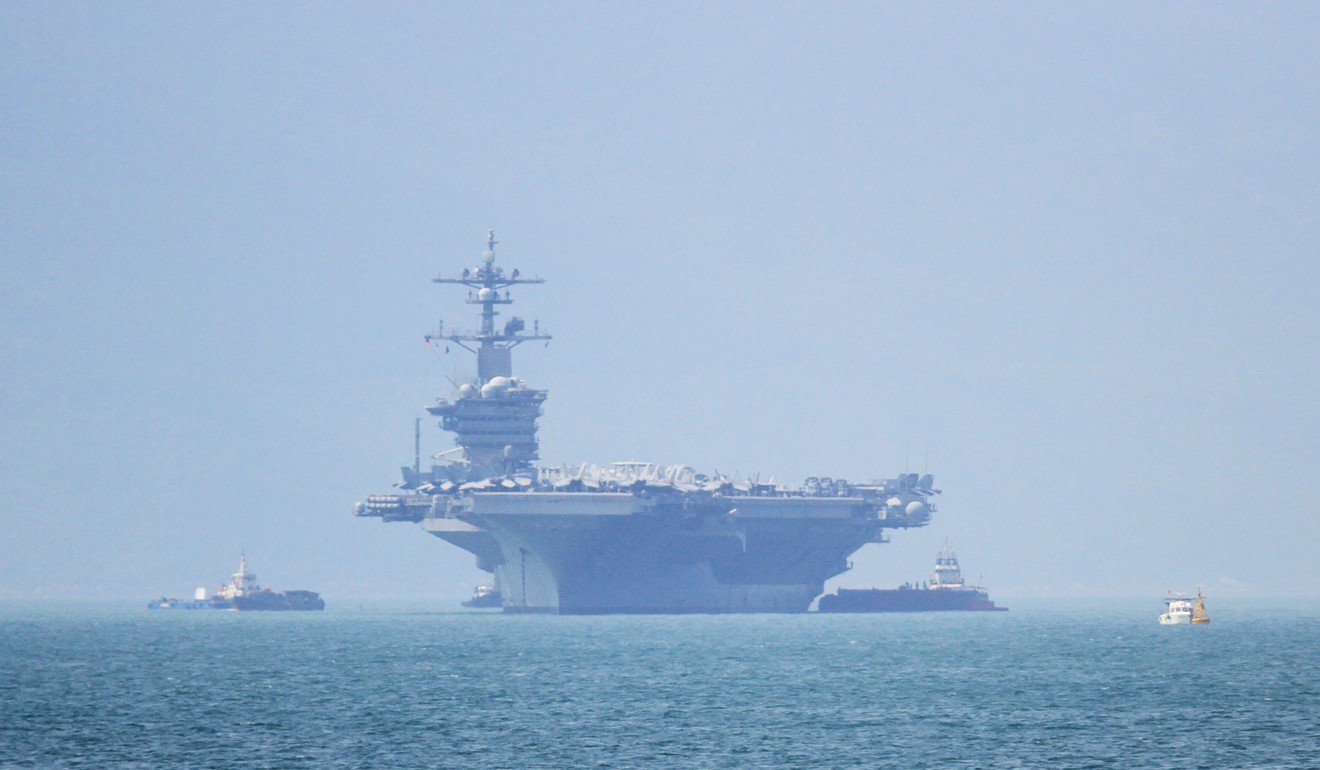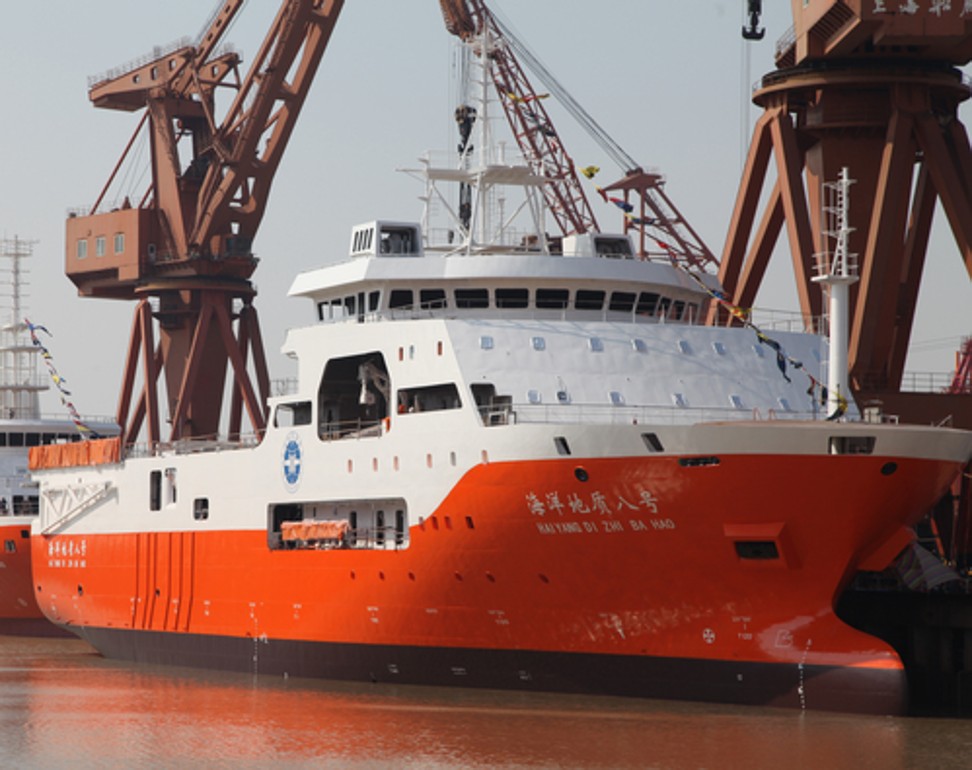
US navy aircraft carrier Theodore Roosevelt to visit Vietnam as South China Sea tensions simmer
- The US has identified former foe Vietnam as a strategic partner in the resource-rich waterway, most of which is claimed by China
- The USS Theodore Roosevelt’s visit will mark the second time a US Navy ship has docked in the country since the Vietnam War ended in 1975

American Navy aircraft carrier USS Theodore Roosevelt will visit Vietnam this week, with a stop scheduled at the coastal city of Da Nang on Thursday.
Designed as a symbolic show of unity amid simmering tensions in the resource-rich South China Sea, the vessel’s arrival serves as a statement of intent to China.
United States Ambassador to Vietnam Daniel Kritenbrink, US Pacific fleet commander John C. Aquilino and US Consul General Marie Damour will represent the American delegation at a welcome ceremony on Thursday, where Vietnamese dignitaries will also be in attendance.
Bill Hayton, associate fellow of the Asia-Pacific Programme at Chatham House, believes the visit has long been in the pipeline.
“Ship visits take a long time to organise, so I imagine this was planned several months ago. The message is to demonstrate the further development of military relations between the two countries. There can be little doubt the message is aimed at China,” said Hayton, the author of The South China Sea: The Struggle for Power in Asia.
“It is significant that this visit is taking place at a time of heightened tension in the South China Sea,” he added.
“Last year, China trespassed in the Exclusive Economic Zones (EEZs) of Vietnam and Malaysia with oil survey ships escorted by its coastguard. Earlier this year, it sent a flotilla of fishing boats, also escorted by the coastguard, into the EEZs of Malaysia, Indonesia and Vietnam. Vietnam is unable to protect its maritime resources from China so it is seeking international support for its position.”

The event will mark the second time a US Navy ship has docked in the Southeast Asian country since the Vietnam war ended in 1975. In March 2018, a visit from USS Carl Vinson with more than 5,000 crew formed the largest US military presence in Vietnam since the communist victory over South Vietnam and the withdrawal of American troops.
Shortly after the USS Carl Vinson docked, uniformed navy officers performed a lighthearted rock concert for child sufferers of Agent Orange. The show acted as a metaphor for the improved camaraderie and budding relations between the two former foes.
This week, as much as in 2018, it is likely China’s long shadow will loom over proceedings in the same way the nation attempts to exert its influence over the South China Sea. China claims almost all of the region, using its infamous nine-dash-line map to demarcate its desired territory, which includes waters recognised internationally as belonging to Vietnam.
Gas and oil exploration in the South China Sea is a deeply fraught issue. The conflict between the two nations often centres on the disputed Spratly and Paracel Islands, where China has built artificial reefs and set up military facilities. The two nations engaged in bloody battles over the islands in the 1970s and 80s.
Last year, tensions rose once more between Hanoi and Beijing after Chinese survey ship Haiyang Dizhi 8 repeatedly entered Vietnam’s EEZ while searching for gas and oil reserves. In 2014, a series of deadly protests erupted in Vietnam after a Chinese drilling rig ventured into disputed waters.
Following last year’s tensions, US secretary of defence Mark Esper visited Vietnam in November to announce the US would gift Vietnam a coastguard cutter to boost patrols in the region.
After the last US Navy visit in 2018, China expressed its displeasure over the docking and closely monitored the situation.
One diplomat in Hanoi, who declined to be named as he is not authorised to speak to the media, believes this year’s visit is part of bilateral celebrations of the 25th anniversary of diplomatic relations between the US and Vietnam.
“The ship’s presence in Vietnam may not bother China, but rather, it is where the ship heads next which may be of concern,” he said.
Carl Thayer, professor emeritus at the University of New South Wales Canberra and a regional expert on Southeast Asia, said the visit of the USS Theodore highlights how the US “intends to remain the pre-eminent naval power in the Western Pacific and South China Sea”.
The US, in various strategic policy documents, has identified China as a rival and competitor. The documents also identify Vietnam as a priority strategic partner and criticise China for acts of intimidation in the South China Sea.
“The visit to Da Nang by the USS Theodore Roosevelt aircraft carrier is one of three prongs in US military strategy,” said Thayer. “These prongs are: continuous naval presence patrols, continuous bomber presence patrols, and freedom of navigation operational patrols. The visit of the USS Theodore Roosevelt is a demonstration of US commitment to the region and that its presence in the South China Sea is welcomed by Vietnam.”
According to Hainan maritime safety officials, China has sent energy exploration vessel Hai Yang Shi You 719 into areas near the Paracel Islands from February 27 to April 30, which overlaps with the USS Theodore visit.
“On the face of it, the deployment of the Hai Yang Shi You 719 would appear to be both a commercial decision and a demonstration of China’s sovereignty rights,” Thayer said. “If China were really exercised by the visit of a US Navy aircraft carrier to Da Nang, it would respond by some demonstration of its air and naval might.
“China and Vietnam have conflicting claims over the Paracels,” he added. “Chinese scholars are now mirroring the Asia Maritime Transparency Initiative (AMTI) by publishing information on Vietnamese militia and fishing fleet using automatic identification system (AIS) data. Recent Chinese reports indicate a rise in the presence of Vietnamese fishing boats in the Paracels. The deployment of the Hai Yang Shi You 719 is likely to be a Chinese response.”
Taiwan, Malaysia, Brunei, and the Philippines also claim areas of the conflicted region that Beijing says belong to China.
Just two weeks ago, the Washington-based AMTI think tank claimed a fresh stand-off over energy exploration in the South China Sea involving China, Malaysia and Vietnam had been brewing out of the public eye for weeks.
AMTI, which is affiliated to the Center for Strategic and International Studies, said it made its findings based on the vessels’ AIS broadcasts and commercial satellite imagery. It raised questions as to why Malaysia and Vietnam confronted each other instead of uniting against China’s claims.
This development follows conflict between Indonesian and Chinese vessels near the Natuna islands in December.
Indonesia deployed warships and fighter jets to the area after a Chinese coastguard vessel was spotted escorting Chinese fishing boats around the islands. In January, it also mobilised its fishermen to defend Indonesia’s sovereignty in its waters.
President Joko Widodo issued sharp statements over the conflict, saying there was “no negotiation when it comes to our sovereignty”.
